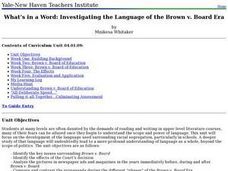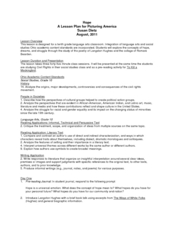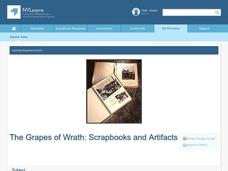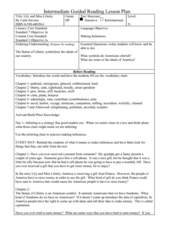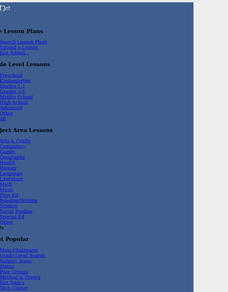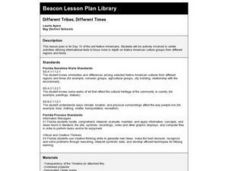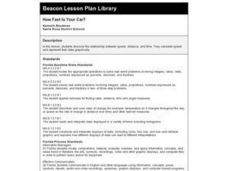Curated OER
What's in a Word: Investigating the Language of the Brown v. Board Era
Young scholars focus on the development of the language used surrounding racial segregation, particularly in schools. They identify the key issues surrounding Brown v. Board and identify the effects of the Court's decision. They analyze...
Curated OER
Elements of Short Stories Vocabulary
In this literature worksheet, students match the correct word from the first column to the best definition found in the second column. There are twenty words and definitions to match.
Curated OER
Response to Literature: Feelings About the Book
Learners read chapter 17 in the story NUMBER THE STARS and think about the author's purpose for writing the book. They are encouraged to share with the class their personal reactions to the story.
Curated OER
Wild Things - Texture And Pattern
Students implement textures and patterns in creating an imaginary Wild Thing, using the book and illustrations in Where the Wild Things Are by Maurice Sendak serve as Inspiration.
Curated OER
First Letter Changes
Students use the books of Eric Carle to change the first letter in a word to see a new word. In this phonics lesson plan, students change the beginning letters in poems and books.
Curated OER
Edgar Allan Poe Lessons
Students can learn about literary techniques, such as imagery and symbolism, by exploring these Edgar Allan Poe lesson plans.
Curated OER
Lord Jim by Joseph Conrad
In this literature worksheet, students respond to 21 short answer and essay questions about Joseph Conrad's Lord Jim. Students may also link to an online interactive quiz on the novel at the bottom of the page.
Curated OER
The Desert Alphabet Book
Students explore world geography by researching a science book with their classmates. In this desert identification lesson, students utilize a U.S. map to locate the geographical locations of deserts. Students create an oral report based...
Curated OER
Le Père Goriot by Honoré de Balzac
In this literature worksheet, students respond to 25 short answer and essay questions about Le Pere Goriot. Students may also link to an online interactive quiz on the novel at the bottom of the page.
Curated OER
Picturing America: Images and Words of Hope from Romare Bearden and Langston Hughes
A carefully crafted three-day lesson integrates poetry and visual art. By analyzing and comparing Langston Hughes' poem "Mother and Son" and Romare Bearden's collage "The Dove," readers explore the theme of hope. The lesson activates...
Curated OER
The Grapes of Wrath: Scrapbooks and Artifacts
High schoolers complete research to enhance their reading of "The Grapes of Wrath". Using the text, they identify and locate cultural artifacts and discuss their symbolic connotations. As a class, they create a museum exhibit of the...
Curated OER
Parking Pass
Young scholars look at the rights and laws created to assist individuals with physical disabilities. In this lesson on fair treatment for all, students discuss symbols that related to people with disabilities. They create a new...
Curated OER
Arthur: The Once And Future King
Middle and high schoolers work in groups to research tales of King Arthur, using primary sources. They present the major themes and symbols from these stories, and discuss how they still relevant in today's world. Use this lesson to...
Curated OER
Lily and Miss Liberty
Students discuss ways to earn money and why they might need it. Students create crowns to wear all day like in the story. Students create a play using characters in the story. Students interview "eyewitnesses" at the unveiling of the...
Curated OER
Reading Response Journal Lit Logs
Here is a worksheet presenting many ways to create topics and start sentences. The writing prompts are best used for young writers who are creating reading response journals or literature logs. Sometimes, all a writer needs is a good...
Curated OER
The Death of a Salesman Act I: the Lowman Family & their American/Capitalist Dreams
This thirty-slide presentation, designed to accompany a lecture on the first act of Arthur Miller's The Death of a Salesman, would be appropriate for a college-level American literature class or perhaps as a teacher resource.
Curated OER
Close Reading
Eleventh graders read and study Hamlet. Then they are introduced to close reading as a means of understanding what is being read--not only understanding the printed word, but also the nuances and connotations of language as it is used by...
Curated OER
Different Tribes, Different Times
Second graders study the different types of Native American culture groups. They, in groups, visit four different work stations to examine various culture groups and complete a Corn Cycle worksheet.
Curated OER
How Fast Is Your Car?
Eighth graders discover the relationship between speed, distance, and time. They calculate speed and represent their data graphically. They, in groups, design a ramp for their matchbox car. The goal is to see who's ramp produces the...
Curated OER
Where Is Japan? How Are We Alike And Different?
First graders use literature, maps, and globes to explain how physical environments in various parts of the world are similar to and different from one's own, and that certain areas have common characteristics and can be called regions.
Curated OER
The Wall Inspires Letters to Veterans
Students examine the Vietnam war. They listen to and discuss the book, "The Wall," by Eve Bunting, conduct Internet research, and write a letter or send a card to U.S. military veterans in a local Veteran's Hospital.
Curated OER
Technologies of the Civil War
Fifth graders discover new and interesting technologies of the Civil War. In this Civil War portfolio of lessons, 5th graders analyze primary resources, develop new vocabulary, investigate websites, and create a time line of new...
Curated OER
Voices From Your Heart
Students create individual representations of Chinese calligraphy symbols in this cross-curricular instructional activity for the elementary Language Arts or Art classroom. One enrichment activity is included.
Curated OER
Geometric Glances
Second graders locate, comprehend, interpret, evaluate, maintain, and apply information, concepts, and ideas found in literature, the arts, symbols, recordings, video and other graphic displays, and computer files in order to perform...


